Small, powerful, and oh, so healthy, these little greens are dynamite in a tiny package. Don’t let their diminutive nature fool you; microgreens are a superfood to contend with. You’ve probably seen microgreen growing kits before or spotted a tray of greens on your friend’s counter and may be wondering what the deal is with these just-sprouted seeds. Are they really as healthy as everyone claims? Should you be eating them? Read on for our favorite health benefits of microgreens and ways they can supercharge your health.
What are microgreens?
Though it is easy to confuse the two, microgreens and sprouts are different. Sprouts are newly germinated seeds that are harvested as soon as the seed sprouts but before the leaves develop. Microgreens, on the other hand, are grown from sprouts and are harvested once the leaves have developed.
Microgreens can be grown in a hydroponic container (meaning water is used instead of soil), or they can be grown traditionally in a soil tray and harvested 1-2 weeks after planting when they are around two inches tall. They are pretty foolproof and straightforward to grow even if you don’t have a green thumb.
Microgreens are their own category of the plant, but they are actually grown from vegetable seeds and just not allowed to reach maturity. For instance, common plants that are used for microgreens include:
- amaranth
- basil
- kale
- broccoli
- mustard
- tatsoi
- orach
- borage
- beet
- parsley
- pea
- red pak choi
- kohlrabi
- Swiss chard
- rocket
Microgreen packets will usually include a combination of seeds since each plant will produce microgreens with a different flavor, color, and texture, which keeps things interesting. Many people prefer these young greens over the actual plant because they are often loaded with even more nutrients, are usually more tender than their mature cultivars, and are easier to incorporate into your diet.
Why microgreens are good for you
Loaded with antioxidants
Since microgreens are such a concentrated source of nutrients, it makes sense that they are loaded with antioxidants. Antioxidants are a critical component of a healthy diet because they work to rid the body of free radicals that can accumulate and contribute to chronic diseases such as cancer. They are a great way to “eat the rainbow,” meaning that you will be getting an adequate amount of antioxidants from vegetables of every color in just a few bites of microgreens.
Heart disease
It is well known that a healthy diet full of fresh foods is one of the best ways to lower your risk of developing heart disease. However, microgreens may be even more beneficial as animal studies have shown that they may lower triglyceride and “bad” LDL cholesterol levels in the body.
Concentrated nutrients
Microgreens often have up to nine times higher the amount of vitamin, mineral, and antioxidant levels than the same quantity of mature greens, which is a staggering statistic considering how easy they are to eat and include in your diet. Many varieties have even been shown to contain more potassium, iron, zinc, magnesium, and copper as well.
A note on sustainability
Microgreens have gotten a lot of good press in recent years, not just for their nutritional value, but for their sustainability as well. They are super easy to grow, don’t require a ton of space, and can even be grown without soil. Setting up a microgreen growing rotation to ensure that you will have fresh microgreens at all times is incredibly simple and will allow you and your family to have fresh, homegrown vegetables all year.
How to add them to your diet
Smoothies
Throw some microgreens into your smoothies or juices to amp up the nutritional value and allow you to eat a large amount.
Sandwiches and salads
Using microgreens on sandwiches or salads not only increases the nutrients of your lunch but will also improve the aesthetic value as well. Sprinkle some microgreens on your freshly grilled chicken and avocado wrap, and you have an eye-catching masterpiece fit for Instagram.
Use them as a garnish
Since microgreens aren’t bitter, their unique flavor can really enhance any savory dish, whether it’s warm or hot. Try using them on top of soups, stir-fries, or any of your other favorite meals.
-Susan Patterson

